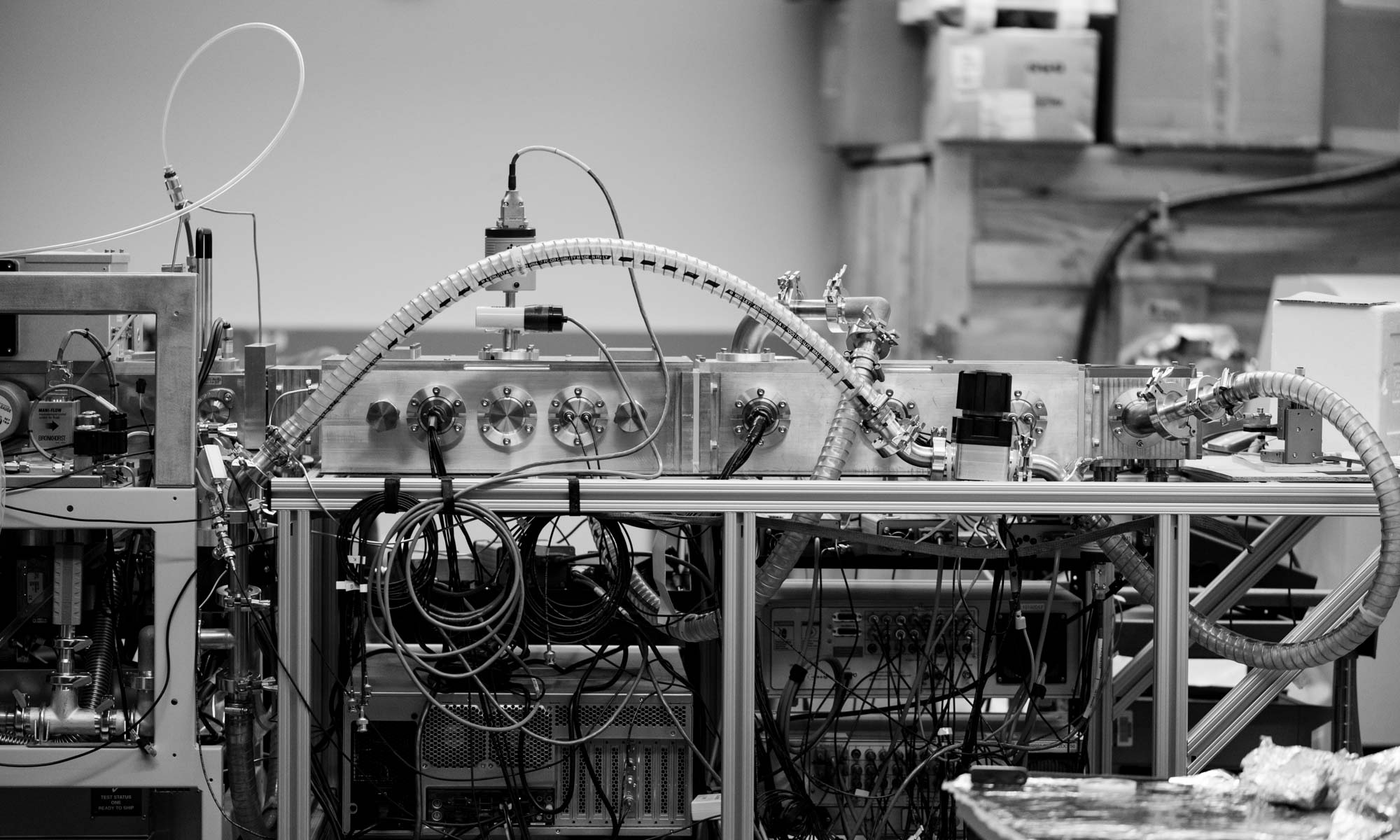 Gas-phase conformations and electron transfer dissociations of pentapeptide ions containing the photo-Leu residue (L*) were studied. Exhaustive conformational search including molecular dynamics force-field, semi-empirical, ab initio, and density functional theory calculations established that the photo-Leu residue did not alter the gas-phase conformations of (GL*GGK + 2H)2+ and (GL*GGK-NH2 + H)+ ions, which showed the same conformer energy ranking as the unmodified Leu-containing ions. This finding is significant in that it simplifies conformational analysis of photo-labeled peptide ions. Electron transfer dissociation mass spectra of (GL*GGK + 2H)2+, (GL*GGK-NH2 + 2H)2+,(GL*GGKK + 2H)2+, (GL*GLK + 2H)2+, and (GL*LGK + 2H)2+ showed 16 %–21 % fragment ions originating by radical rearrangements and cleavages in the diazirine ring. These side-chain dissociations resulted in eliminations of N2H3, N2H4, [N2H5], and [NH4O] neutral fragments and were particularly abundant in long-lived charge-reduced cation-radicals. Deuterium labeling established that the neutral hydrazine molecules mainly contained two exchangeable and two nonexchangeable hydrogen atoms from the peptide and underwent further H/D exchange in an ion–molecule complex. Electron structure calculations on the charge-reduced ions indicated that the unpaired electron was delocalized between the diazirine and amide π* electronic systems in the low electronic states of the cation-radicals. The diazirine moiety in GL*GGK-NH2was calculated to have an intrinsic electron affinity of 1.5 eV, which was further increased by the Coulomb effect of the peptide positive charge. Mechanisms are proposed for the unusual elimination of hydrazine from the photo-labeled peptide ions.
Gas-phase conformations and electron transfer dissociations of pentapeptide ions containing the photo-Leu residue (L*) were studied. Exhaustive conformational search including molecular dynamics force-field, semi-empirical, ab initio, and density functional theory calculations established that the photo-Leu residue did not alter the gas-phase conformations of (GL*GGK + 2H)2+ and (GL*GGK-NH2 + H)+ ions, which showed the same conformer energy ranking as the unmodified Leu-containing ions. This finding is significant in that it simplifies conformational analysis of photo-labeled peptide ions. Electron transfer dissociation mass spectra of (GL*GGK + 2H)2+, (GL*GGK-NH2 + 2H)2+,(GL*GGKK + 2H)2+, (GL*GLK + 2H)2+, and (GL*LGK + 2H)2+ showed 16 %–21 % fragment ions originating by radical rearrangements and cleavages in the diazirine ring. These side-chain dissociations resulted in eliminations of N2H3, N2H4, [N2H5], and [NH4O] neutral fragments and were particularly abundant in long-lived charge-reduced cation-radicals. Deuterium labeling established that the neutral hydrazine molecules mainly contained two exchangeable and two nonexchangeable hydrogen atoms from the peptide and underwent further H/D exchange in an ion–molecule complex. Electron structure calculations on the charge-reduced ions indicated that the unpaired electron was delocalized between the diazirine and amide π* electronic systems in the low electronic states of the cation-radicals. The diazirine moiety in GL*GGK-NH2was calculated to have an intrinsic electron affinity of 1.5 eV, which was further increased by the Coulomb effect of the peptide positive charge. Mechanisms are proposed for the unusual elimination of hydrazine from the photo-labeled peptide ions.
Electron Transfer Dissociation of Photolabeled Peptides. Backbone Cleavages Compete with Diazirine Ring Rearrangements Aleš Marek, Robert Pepin, Bo Peng, Kenneth J. Laszlo, Matthew F. Bush, František Tureček. J. Am. Soc. Mass Spectrom. 2013, DOI:10.1007/s13361-013-0630-0. (Link|PUBMED)

 We just received our second mass spectrometer, a Waters Synapt HDMS, quadrupole/ion-mobility/time-of-flight hybrid mass spectrometer.
We just received our second mass spectrometer, a Waters Synapt HDMS, quadrupole/ion-mobility/time-of-flight hybrid mass spectrometer. The cryptochrome (CRY) flavoproteins act as blue-light receptors in plants and insects, but perform light-independent functions at the core of the mammalian circadian clock. To drive clock oscillations, mammalian CRYs associate with the Period proteins (PERs) and together inhibit the transcription of their own genes. The SCFFBXL3 ubiquitin ligase complex controls this negative feedback loop by promoting CRY ubiquitination and degradation. However, the molecular mechanisms of their interactions and the functional role of flavin adenine dinucleotide (FAD) binding in CRYs remain poorly understood. Here we report crystal structures of mammalian CRY2 in its apo, FAD-bound and FBXL3–SKP1-complexed forms. Distinct from other cryptochromes of known structures, mammalian CRY2 binds FAD dynamically with an open cofactor pocket. Notably, the F-box protein FBXL3 captures CRY2 by simultaneously occupying its FAD-binding pocket with a conserved carboxy-terminal tail and burying its PER-binding interface. This novel F-box-protein–substrate bipartite interaction is susceptible to disruption by both FAD and PERs, suggesting a new avenue for pharmacological targeting of the complex and a multifaceted regulatory mechanism of CRY ubiquitination.
The cryptochrome (CRY) flavoproteins act as blue-light receptors in plants and insects, but perform light-independent functions at the core of the mammalian circadian clock. To drive clock oscillations, mammalian CRYs associate with the Period proteins (PERs) and together inhibit the transcription of their own genes. The SCFFBXL3 ubiquitin ligase complex controls this negative feedback loop by promoting CRY ubiquitination and degradation. However, the molecular mechanisms of their interactions and the functional role of flavin adenine dinucleotide (FAD) binding in CRYs remain poorly understood. Here we report crystal structures of mammalian CRY2 in its apo, FAD-bound and FBXL3–SKP1-complexed forms. Distinct from other cryptochromes of known structures, mammalian CRY2 binds FAD dynamically with an open cofactor pocket. Notably, the F-box protein FBXL3 captures CRY2 by simultaneously occupying its FAD-binding pocket with a conserved carboxy-terminal tail and burying its PER-binding interface. This novel F-box-protein–substrate bipartite interaction is susceptible to disruption by both FAD and PERs, suggesting a new avenue for pharmacological targeting of the complex and a multifaceted regulatory mechanism of CRY ubiquitination.

 Congratulations to
Congratulations to 

 Congratulations to
Congratulations to 
 The Bush Lab welcomes Tracy Stanzel! Click
The Bush Lab welcomes Tracy Stanzel! Click
You must be logged in to post a comment.